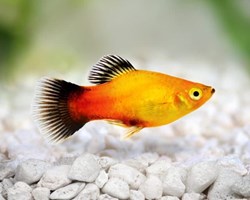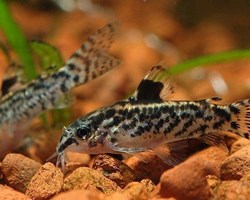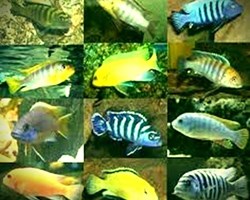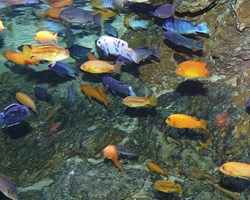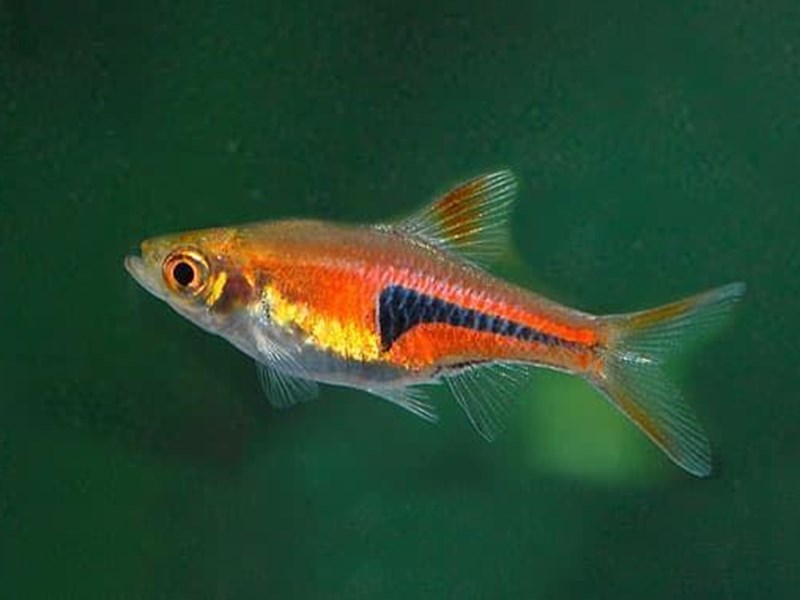
DESCRIPTION: OF THE HARLEQUIN FISH:
Scientific name: Trigonostigma Heteromorpha.
Common name: Harlequin fish, Rasbora heteromorpha.
Aquarium size: 100 liters.
Temperament: Calm.
Temperature: Between 21º and 28ºC.
pH: Between 5 and 7.5.
Diet: Omnivores.
Length: 4.5 cm.
The Harlequin fish or Harlequin Rasbora, is a fresh and warm water fish belonging to the Cyprinidae family.
It has been present in aquariums since the early 1900s, when the first Harlequin fish arrived in aquariums.
Its growing popularity is due in large part to being a fish that is very resistant to disease, in addition to being a very sociable fish, an attitude that allows it to share space with a wide variety of different species, we could say that it is one of the 10 fish suitable for beginning aquarists.
Currently we can find different varieties of harlequin fish:
- Harlequin rasbora (gold color),.
- Harlequin black rasbora.
- Harlequin blue rasbora.
It is a beautiful freshwater fish with a warm temperature that has recently become popular.
It is sociable with other fish and very resistant to many diseases.
The scientific name of the harlequin fish is Trigonostigma heteromorpha, the latter comes from the Greek and means "different form", to mention that its form differs from other fish of the same genus.
Its common name is given by the similarity of the triangular figure found on its body equal to that of the harlequins.
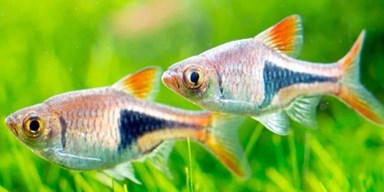
THE GENERAL CHARACTERISTICS OF THE HARLEQUIN FISH:
When these fish reach sexual maturity and suitable conditions can reach 20 cm, weighing 4 kg. They generally measure 50 centimeters.
Rasbora heteromorpha is one of the most common and well-known aquarium fish ever available at Glu Glu Pet.
It is a robust species of easy maintenance.
Rasbora are schooling fish found in nature in large groups.
Originally from Southeast Asia, it is a species that we find in all cases in stores bred in captivity.
Due to this origin, it allows us to easily maintain it in neutral mineralized waters, contrary to what we would need if its origin were wild, where the water should be acidic and free of minerals.
Rasboras belong to the Cypriniformes order and to the Cyprinidae family.
This family includes about 1,500 species.
Cyprinids are distributed on most continents except Australia and South America.
Due to their great geographical distribution, the Cyprinids have very different shapes, sizes and colors.
This family of fish does not have teeth, it functions as pharyngeal bones at the bottom of the throat, it has cyclical scales on the body and is devoid of them on the head.
The Rasbora genus was defined by Bleeker in 1859 and included in the Rasborinidae subfamily with about 30 species, of which 10 can be found regularly in the trade.
They are pelagic species that swim at medium height without contact with the bottom.
We can find many differences in size in the most common species, between the 2.5 cm of the smallest Rasbora maculata and the 20 cm of Rasbora elegans, the largest of the genus.
The Rasbora heteromorpha has a size of around 4.5 cm.
It is native to Thailand, Singapore, Malaysia and the Island of Sumatra in Indonesia.
This great distribution causes important variations in the coloration of its populations that affects its red and violet tones.
It was first described for the aquarium hobby by Duncker in 1904.
Its first import to Europe dates back to 1906.
The Rasbora heteromorpha is named for its diamond shape, it has a small head in proportion to the body facing upwards.
Its hallmark is the dark triangular area that it shows on the back of its body.
This dark area begins at the height of the dorsal fin, joining with the pelvic fins and ends in a point at the level of the caudal peduncle. This dark triangle makes it possible to determine the species and, with a little experience, the distinction between the sexes.
R. heteromorpha and R. espei (Rasbora de espe) are very similar, although the latter is less common in trade.
The Rasbora espei is endemic to Sumatra and was imported to Europe for the first time in 1967, being described that same year by Meinken.
Its size is somewhat smaller, 3.5 cm.
Its general morphology is similar to the heteromorpha although it has a less elevated body maintaining its rhomboid shape.
Its coloration is more discreet, presenting a much smaller black triangle, even twice less, than in Rasbora heteromorpha.
The harlequin rasbora; Trigonostigma heteromorpha, is a tropical fish of the Cyprinidae family.
Often referred to as harlequins, they are one of the most popular rasbora species for home aquariums.
This species is native to Asia and is commonly seen around Malaysia, Singapore, and Thailand.
Here they inhabit rivers, streams, and swampy forests that resemble the blackwater habitats of South America.
These little schooling fish are easy to care for, so they shouldn't have much trouble.
They can be cared for by people with low experience levels. This makes them perfect for beginners starting a community aquarium. A small group adds some color and shoaling behaviors to mid tank levels.
They are peaceful, so they get along with other peaceful fish, but can become a snack for larger species.
It will not cost you to find harlequins; They are usually in high demand, so most aquarium stores carry them. You should expect to pay between 2 and 4 euros for each fish.
These rasboras rarely grow more than 3 centimeters. Since they are small, a few can comfortably fit in a single aquarium.
Its body has a high midsection but tapers towards the mouth and forked tail fin.
The rear half of the body has a black spot that narrows with the body and stops at the tail fin. This black spot is what gives this fish its name, being similar to the black patterns found on a classic harlequin costume.
The rest of the body is silver, with hints of orange.
Fins are darker orange but can vary in color intensity.
This depends on many factors such as tank conditions, stress levels of the fish, and the population they were bred from.
Although these designs are not flashy on their own, a group can create quite a show. This is the same for other fish too, like neon tetras.
It can be difficult to tell the difference between males and females. Males tend to have slightly larger black spots and a more rounded section where the anal fin joins.
In the wild, a harlequin rasbora's habitat can range from rivers, to forests to peat swamps. Although conditions differ between these habitats, there are some things that are constant.
The waters of these areas are tropical, so the temperatures will be quite warm and the pH will be almost neutral, these fish will not survive in conditions of extreme acidity or alkalinity.
Swamp forests will have waterlogged soil substrates, while rivers are more sandy. Plants surrounded by rocks will be planted in the substrate.
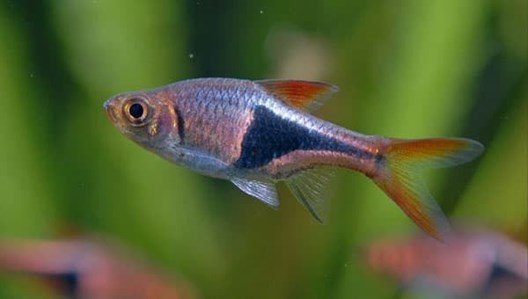
The Harlequin fish is a really small fish, in freedom it does not usually exceed 3.2 centimeters, although in captivity it can grow a little more, up to 4.5 centimeters.
Its usual color varies from reddish, to pink or orange, with a black triangle-shaped stripe, which runs from the dorsal fin to the middle of the base of the caudal fin.
The colors can be altered under different circumstances, such as the quality of the water, the health of the fish, even depending on its mood and the season of heat.
They have an oval body, compressed on the sides.
The mouth of the Harlequin fish is oriented upwards, possibly because it is a fish that feeds on the surface of the water.
Between males and females, there are no major differences, except that adult females are usually rounder and larger than males, thinner and more colorful.
Another way to distinguish females from males is that the triangular marking is sharper and better defined on males, while on females it has a more rounded outline.
These beautiful fish have a brown tone as their base color that is mixed with orange, red or yellow, with bright blue areas on their head and body.
In the dorsal fin the accentuated bright red color is evident.
It has sharp teeth that are compared to daggers, similar to those of the coral trout, the females usually have a rounded belly and the males are thin and the colors are more vivid.
They have a black triangle-shaped stripe from the dorsal fin to the base of the caudal, this is more marked and defined in males than in females.
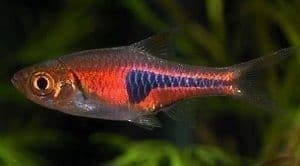
TO KNOW MORE ABOUT THIS SPECIES, IT IS NECESSARY TO KNOW ITS DISTRIBUTION AND HABITAT:
This species of fish is native to southern Thailand, Malaysia, Singapore, and the islands of Borneo and Sumatra.
It appears that the species caught in southern Thailand are somewhat smaller and slimmer than those from Singapore and the islands of Borneo and Sumatra.
Its natural habitat is gentle streams, with an abundance of vegetation.
The water is usually soft, slightly acidic and with little light, due to the large amount of vegetation present, since these waters usually belong to rivers with a large number of trees.
They are native to the state of Western Australia, as well as Thailand.
Although they can be found in southern Albany and on the Abrolhos Islands.
When they are found they are generally found on reefs, brush and sand with depths ranging from 5 to 35 meters.
Its place of habitat is soft water that is not very acidic and poorly lit with a lot of vegetation or trees.
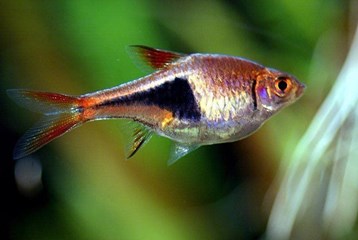
THE BEST CONDITIONS OF THE AQUARIUM:
The size of the aquarium should be about 100 liters, with a dark substrate bottom or instead and recreating its natural habitat, a sandy bottom should be placed in which to include roots and wooden branches, which form shady holes and caves. where they can hide.
Dry beech or oak leaves can be added to the aquarium to give a greater sense of naturalness.
These leaves, when they begin to decompose, will serve as food for the fry.
Aquarium lighting should be dim.
The waters in which they move are not very illuminated and a change of environment would not suit them.
Its ideal temperature for water ranges between 21º and 28ºC, with a pH between 5 and 7.5.
For those beginners or those who already have aquariums, but still do not know the needs of this brilliant fish, we bring a series of steps that must be followed to provide adequate conditions:
- The size of the aquarium must cover at least 100 liters of water.
- At the bottom there should be roots, wood and sand, this should produce shade where they can hide.
- The light should be dim or dim.
- The temperature between 21 to 2 degrees C.
- The pH between 5-7.5.
- Oak and almond leaves can be placed, this stimulates microbes and favors the development of the fry.
- Maintain a balanced diet with all groups.
- These fish are perfect for beginners, now you can have new friends to take care of with easy adaptation and without major demands.
We do not need a very large aquarium to keep our Rasboras.
A volume of 60 liters allows us to safely maintain a school of a dozen individuals.
We remember that it is a kind of school and should not be kept individually or in pairs.
It is a species suitable for the community aquarium, so it can be accompanied by many other peaceful species.
We will try to give the aquarium a decoration that tries to reproduce its original biotope.
The quality of the water as mentioned is not critical.
The strong presence of natural plants would be the ideal decoration.
Originally, they live in waters with a high presence of leaves and other plants, being very rich in humic acids.
It is a habitat very similar to that of the black waters of the Amazon.
Although we can keep it in neutral waters by lowering the pH a little to 6 with a low mineral load, we will achieve the best colorations.
Maintained in neutral waters of medium hardness we will not achieve its reproduction.
Filtering with peat to achieve an amber hue in the water would be perfect to help recreate its natural habitat.
The life expectancy of the Rasboras is between 5 and 8 years.
They are very robust fish with easy adaptability.
Appreciates regular water changes to lower the amount of nitrates present to which they may be sensitive.
A dark gravel bottom together with black rocks of volcanic origin and some roots will perfectly complete the decoration of our aquarium.
Microsorum pteropus and Cryptocorynas in general would be the most suitable plants due to their great robustness and decorative appearance.
The cryptocorinas present large species such as:
- Cryptocoryne celiata.
- C. usteriana.
- C. wendtii.
Small species like:
- C. beckettii.
- C. willlisi.
This allows us to decorate the tank with plants of different sizes, giving the installation depth.
These plants are slow growing species with low light requirements.
What is difficult for them to adapt but once achieved have a long life.
Floating plants of the genus Ceratopteris and Pistia are perfect for dimming the lighting in aquariums with a lot of light, creating very attractive shaded areas in areas of the aquarium.
Rasboras are species especially suitable for the community aquarium, both biotope and with other species with similar aquatic requirements.
Pacific dwarf cichlids of South American origin, among others, are especially indicated for an adequate coexistence.
Even discus fish can be kept in common with our harlequins as they tolerate similar water conditions.
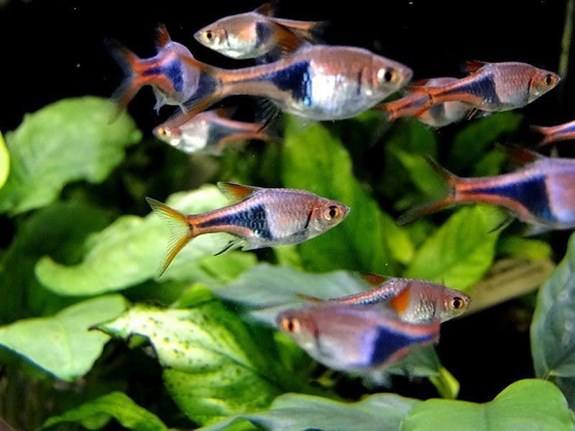
THE BEST NUTRITION FOR THE HARLEQUIN FISH:
It is an omnivorous fish, which in freedom feeds on small insects that fall into the water, worms, crustaceans and zooplankton.
In the aquarium, to maintain a balanced diet, we must provide good quality dry food, supplemented with live food that we can get ourselves, or alternatively, frozen food, such as earthworms, Daphnia and Artemia.
It is a type of fish that belongs to the family of omnivores, they need to have a balanced diet.
They can accept foods such as: small fish, scales, frozen foods such as worms, daphnia, brine shrimp, freeze-dried foods.
We must be aware of their diet to provide them with the necessary requirements and facilitate their proper growth and development.
In their natural habitat they are mostly insectivores.
In captivity it is not a complex species to maintain.
Our Rasboras will gladly accept flakes and all types of freeze-dried food.
Like other small species, they are extremely voracious, so it is more advisable to feed them several times a day in small quantities than a single large meal.
The frozen food, highlighting the red mosquito larva , represents an increase in its vitality and coloration.
Its daily offer together with the exact aquatic conditions will allow us to attend its spawning.
Both Rasbora heteromorpha and R. espei will only reproduce by removing mineralization from the water.
The increase in frozen food that represents the fruitful season of the rainy season generates by itself an incitement to reproduction that will be completed with a total demineralization of the water.
In aquariums dedicated to breeding in which all partners are removed, we may be lucky enough to observe the fry.
The main thing to keep in mind is the size of the meal.
Harlequin rasboras have small mouths, so they will only be able to eat small particles.
In the wild this means that they are restricted to foods such as plant detritus, small insect larvae and eggs.
When it's time to feed, they become active and happily pick up flakes or pellets from the surface.
These have been specially designed to contain a range of nutrients.
This can be done with live or frozen foods: Daphnia, bloodworms, and insect larvae are a few small examples.
Live foods in particular make feeding times interesting by introducing movement.
Although they can eat plants, it is unlikely, so there is no need to worry about damage.
Feed them twice a day, giving them only what they can finish in a couple of minutes.
This is easier on his digestive system than giving it all at once.
Remove any excess food from the tank after feeding time to prevent spoilage.
FOR YOUR BEST CARE YOU MUST KNOW ITS BEHAVIOR AND COMPATIBILITY:
He is peaceful, calm and sociable.
It is recommended to keep them in groups of 8 to 10, in this way they will feel at home.
It is compatible with fish such as catfish, tetras, bettas, loaches, dwarf cichlids, among others.
Fish much larger than themselves should be avoided, as this can lead to them being eaten.
They are peaceful creatures; they will not harass any of their tank mates. If anything, they are more likely to be the victims and will become stressed by boisterous fish.
Most of their time will be spent in the middle layers of the water, rarely traveling to the surface or substratum.
You may see them hiding among plants or in caves, this could be because they are stressed and trying to get away from other fish or bright lights.
When you have a group, you will see some behaviors of the schools of fish.
Harlequins will move around together, sometimes displaying some interesting behaviors.
By themselves they are quite shy, but when they are part of a group they come to life and you will notice that they are much happier and content.
Compatible fish without restrictions are:
- Botia Clown.
- Guppy Endler.
- Guppies.
- Scalar Fish.
- Otocinclus.
- Pearl Gourami.
- Telescope.
- Tiger Barb.
- Ax Fish.
- Nun fish.
- Drunk Tetra.
- Apple Snail.
- Comet Goldfish.
- Molly fish.
- Ramirezi.
- Corydora.
- Tetra Neon.
- female betta.
- Mosquito fish.
- Cherry Barbel.
- Ancistrus.
- Platy fish.
- Chinese neon.
- Rasbora Galaxy.
- Silver Dollar Fish.
- Danio Rio.
Fish compatible with restrictions are:
- Rainbow Fish.
- Discus fish.
- Paradise fish.
- Killi fish.
We are facing a very calm species, which has no problems with any type of fish, except with those that can eat them due to their size.
They are gregarious, so it is advisable to keep a small community of Harlequin fish.
Experts recommend having between 8 and 10 individuals, so that we will achieve a more natural effect, that the males show their best colors, and mainly, we will ensure that they are calmer, with better health.
In a community tank, they might share space with other cyprinids, tetras, small cichlids, even some varieties of betta.
THE REPRODUCTION OF THE HARLEQUIN FISH:
It is possible to breed Harlequin fish in an aquarium, as long as the conditions are right.
The first thing we should know is that this species does not show special care for its eggs, nor for its fry.
They reproduce easily in a well-established aquarium, fish that are at least one year old, and in which there is adequate vegetation, since they usually adhere their eggs to the underside of broad leaves.
For greater control of the reproduction process of the Harlequin fish, a breeding aquarium can be installed.
The aquarium must be conditioned with weak lighting, with a mesh type base or similar, so that the eggs that do not remain attached to the plants and fall to the bottom, are not within the reach of the adult fish, which could eat them.
The temperature of the water must be at the extreme high of the ideal situation, that is, above 28ºC, with a pH between 5 and 6.5.
The weeks before spawning, they should be fed 2 to 3 times a day with small amounts of food, preferably of animal origin: insects, small crustaceans.
We will have evidence that spawning is near, when the males show more vibrant colors and the females appear bulkier.
Spawning usually occurs in the early hours of the morning, and is preceded by a great courtship activity of the male, with races throughout the aquarium.
The female will begin spawning in small groups, which are fertilized by the male.
It will always put a new group, when the previous one is fertilized.
Once spawning is over, it is advisable to remove the adult fish, so that they do not eat the eggs.
The eggs hatch between 24 and 48 hours later.
The fry will swim perfectly, a week.
The most important thing to generate the reproduction of the harlequin fish is the care given to them and the living conditions and habitat of their aquarium, if they are correct it will be possible for your fish to reproduce easily; you should know that they do not take care of their eggs.
At Glu Glu Pet we will show you a list of characteristics of the sexual reproduction of your harlequin fish and what you should know to put into practice the advice you want and the knowledge you get:
- To reproduce they must be at least 1 year old, in the right conditions they will start to do so instantly and naturally.
- You must have adequate vegetation in your aquarium, since their eggs will adhere to the bottom of the leaves that are wide.
- The ideal for its control and reproduction care is to install a breeding aquarium.
- Lighting is essential, it should be dim or dim light.
- A mesh can be placed to prevent them from detaching and falling to the bottom, preventing them from being devoured.
- The water temperature should be favorable, with about 28 degrees C.
- The pH should be between 5 – 6.5.
- They are ready to breed when the colors become brighter in the male and the female's belly becomes more circular.
- The male begins to court the female and then spawns, usually in the early hours of the morning.
- The female will release the eggs by group each time they are being fertilized by the male.
- After this, it is best to remove the adults to prevent them from being eaten.
- After 24 to 48 hours the eggs will hatch and after a week the harlequins will swim without problems.
Unfortunately, they are one of the most difficult species to breed in an aquarium, but it is possible.
They need to be kept healthy and tank conditions should be the same as they would be used to in the wild.
A slightly warmer temperature (around 80°F) will help encourage spawning.
Your fish will also need nutritious protein-packed food; daphnia and bloodworms are good choices.
Keep two females for every male.
These males will put on a display to entice the female to mate.
You will need some broad-leaved plants, such as Anubias Nana, in your aquarium because once ready to spawn, the female will rub her belly on the underside of a leaf to signal the male.
The male will come to fertilize the eggs.
These will stick to the leaf and hatch after 24 hours or so.
Separate the parents from the fry as they will try to eat them.
The fry will be almost completely clean and will feed on their yolk sac for the next 24 hours.
After this, they will have to start feeding them.
Newly hatched prawns are one of the few foods small enough to feed.
A poor diet can affect development.
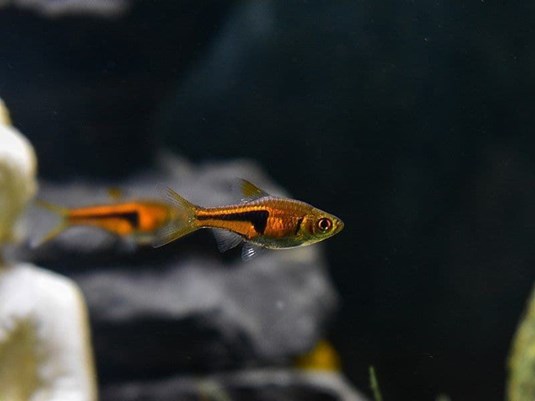
THE BEST CARE OF THE HARLEQUIN FISH:
Harlequins are hardy fish, so they don't get sick very often.
With proper care they are unlikely to experience any problems.
The most common diseases that affect them are problems for many other aquarium fish as well.
Among them are:
- Dropsy, accumulation of fluid that causes swelling.
- The Ich, white spots on the body.
- Fin rot.
These diseases, like many others, thrive in poor quality water.
A dirty tank is one of the main causes of disease outbreaks.
Therefore, cleaning your aquarium is a simple preventive measure to ensure that fish are not lost.
. After cleaning the tank, you could see an improvement in your fish. If not, there are treatments you can buy to help get rid of the condition.
Another factor that increases the likelihood of disease is poor nutrition. If a fish is not getting all the nutrients it needs from its diet, it will be too weak to fight off disease.
Make sure your harlequin fish receive a varied diet that contains the foods listed above. This should give the fish everything they need to stay strong.
If you keep them healthy, they can live 5-8 years.
The Harlequin fish is one of the fish suitable for beginner aquarium enthusiasts, because of how easy they are to handle, compatibility and durability, they can live up to five years.
For best health, the ideal is to try to reproduce their natural habitat as much as possible and keep a densely planted aquarium.

